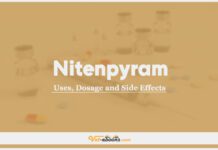Afoxolaner for Dogs, Cats, Pigs, and Birds: Dosage, Uses, and Side Effects Guide

Overview
Afoxolaner acts on ligand-gated chloride channels, especially those that are controlled by the neurotransmitter GABA, to prevent the transport of chloride ions between synapses and across cell membranes.
Uses of Afoxolaner For Dogs, Cats, Pigs, and Birds
- Dogs:
- Treatment of flea and tick infestations.
- Canine demodicosis and sarcoptic mange (sarcoptic acariasis).
- Prevention of infections by Borrelia burgdorferi by eliminating vector ticks.
- Control of multiple tick species:
- Cats:
- Treatment of ear mites (Otodectes cynotis).
- Control of flea infestations (Ctenocephalides felis).
- Pigs:
- Extra-label treatment of sarcoptic mange (Sarcoptes scabiei var suis).
- Birds (Peacocks and Pheasants):
- Treatment of bird louse infestations (Goniodes pavonis).
Afoxolaner Dose For Dogs, Cats, Pigs, and Birds
| Species | Condition Treated with Afoxolaner | Dosage |
|---|---|---|
| Dogs: | Flea and tick control | 2.5–6.9 mg/kg orally once per month |
| Generalized demodicosis | 2.5 mg/kg on days 0, 14, 28, and 56 | |
| Sarcoptic mange | 2.5 mg/kg on days 0 and 28 | |
| Ear mites | 2.5 mg/kg monthly for two months | |
| Cats: | Ear mites and flea infestations | 2.5 mg/kg as a single dose (extra-label) |
| Pigs: | Sarcoptic mange | 2.5 mg/kg orally as a single dose (extra-label) |
| Birds (Peacocks, Pheasants): | Bird louse infestations | 2.5 mg/kg orally as a single dose (extra-label) |
Drug Dosage Calculator
You Should Give:
Common Side Effects of Afoxolaner
- Lethargy, anorexia, pruritus (itching), and neurological signs (e.g., convulsions, ataxia).
- Gastrointestinal symptoms like vomiting and diarrhea (rare).
- Hypersensitivity reactions, including hives and erythema, have been reported.
Contraindications of Afoxolaner
- It is not recommended for dogs younger than 8 weeks or under 2 kg in body weight.
- Use with caution in animals with a history of seizures.
- Safety not evaluated in breeding, pregnant, or lactating animals.
Some Notes:
- Tablet Use and Administration:
- Tablets should not be divided to maintain dosing accuracy.
- Can be administered with or without food. Ensure the full dose is ingested.
- Reproductive Safety:
- Laboratory studies show no teratogenic effects, but safety in breeding, pregnant, or lactating animals is unverified.
- Monitoring and Drug Interactions:
- Monitor for neurological symptoms in predisposed animals.
- Safe for use with vaccines, antibiotics, NSAIDs, and other medications.
- Overdose Management:
- In case of overdose, symptoms may include increased lethargy or tremors. Consult a veterinarian or poison control center for guidance.
Tip
Do You Want To Increase Your Veterinary Knowledge and Practical Skills?
You Can Now Browse and Download +3000 Books For Veterinary Professionals & Students Online.
Download Veterinary Books




















